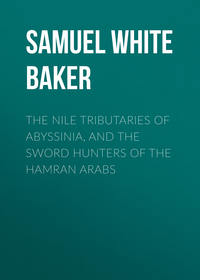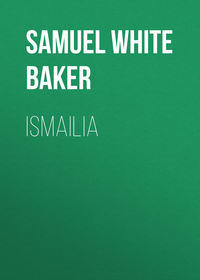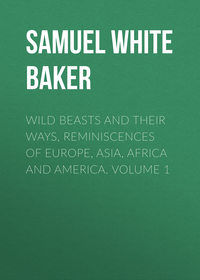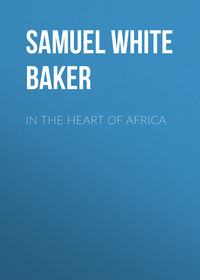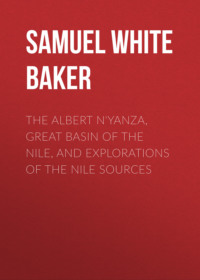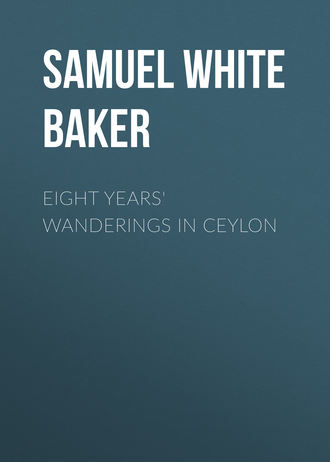 полная версия
полная версияПолная версия
Eight Years' Wanderings in Ceylon
"Confidence," or the want of it, in a hound depends entirely upon the character of his master. There is an old adage of "like master, like man;" and this is strongly displayed in the hound. The very best seizer would be spoiled if his master were a leetle slow in going in with the knife; and, on the other hand, dogs naturally shy of danger turn into good seizers where their master invariably leads them in.
Not only is their confidence required and gained at these times, but they learn to place implicit reliance upon their master's knowledge of hunting, in the same manner that they acknowledge the superiority of a particular hound. This induces them to obey beyond any method of training, as they feel a certain dependence upon the man, and they answer his halloo or the horn without a moment's hesitation.
Nothing is so likely to destroy the character of a pack as a certain amount of laziness or incapacity upon the master's part in following them up. This is natural enough, as the best hounds, if repeatedly left unassisted for hours when at bay with their game until they are regularly beaten off, will lose their relish for the sport. On the other hand, perseverance on the huntsman part will ensure a corresponding amount in the hounds; they will become so accustomed to the certain appearance of their master at the bay at some time or other that they will stick to their game till night. I have frequently killed elk at two or three o'clock in the afternoon that have been found at six in the morning. Sometimes I have killed them even later than this when, after wandering fruitlessly the whole day in every direction but the right one, my ears have at length been gladdened by the distant sound of the bay. The particular moment when hope and certainty combined reward the day's toil is the very quintessence of joy and delight. Nothing in the shape of enjoyment can come near it. What a strange power has that helpless-looking mass—the brain! One moment, and the limbs are fagged, the shins are tender with breaking all day through the densest jungles, the feet are worn with unrequited labor and—hark! The bay! no doubt of it—the bay! There is the magic spell which, acting on the brain, flies through every nerve. New legs, new feet, new everything, in a moment! fresh as though just out of bed; here we go tearing through the jungle like a buffalo, and as happy as though we had just come in for a fortune—happier, a great deal.
Nevertheless, elk-hunting is not a general taste, as people have not opportunities of enjoying it constantly. Accordingly, they are out of condition, and soon be, come distressed and of necessity "shut up" (a vulgar but expressive term). This must be fine fun for a total stranger rather inclined to corpulency, who has dauntlessly persevered in keeping up with the huntsman, although at some personal inconvenience. There is a limit to all endurance, and he is obliged to stop, quite blown, completely done. He loses all sounds of hounds and huntsman, and everything connected with the hunt. Where is he? How horrible the idea that flashes across his mind! he has no idea where he is, except that he is quite certain that he is in some jungle in Ceylon.
Distraction! Ceylon is nearly all jungle, two hundred and eighty miles long and he is in this—somewhere He tries to recollect by what route he has come; impossible! He has been up one mountain, and then he turned to the right, and got into a ravine; he recollects the ravine, for he fell on his head with the end of a dead stick in his stomach just as he got to the bottom; he forgets every other part of his route, simply having an idea that he went down a great many ravines and up a number of hills, and turned to the right and left several times. He gives it up; he finds himself "lost," and, if he is sensible, he will sit down and wait till some one comes to look for him, when he will start with joy at the glad sound of the horn. But should he attempt to find his way alone through those pathless jungles, he will only increase his distance from the right course.
One great peculiarity in Newera Ellia is the comparative freedom from poisonous vermin. There are three varieties of snakes, only one of which is hurtful, and all are very minute. The venomous species is the "carrawellé," whose bite is generally fatal; but this snake is not often met with. There are no ticks, nor bugs, nor leeches, nor scorpions, nor white ants, nor wasps, nor mosquitoes; in fact, there is nothing venomous except the snake alluded to, and a small species of centipede. Fleas there are certainly—indeed, a fair sprinkling of fleas; but they are not troublesome, except in houses which are unoccupied during a portion of the year. This is a great peculiarity of a Ceylon flea—he is a great colonist; and should a house be untenanted for a few months, so sure will it swarm with these "settlers." Even a grass hut built for a night's bivouac in the jungle, without a flea in the neighborhood, will literally swarm with them if deserted for a couple of months. Fleas have a great fancy for settling upon anything white; thus a person with white trowsers will be blackened with them, while a man in darker colors will be comparatively free. I at first supposed that they appeared in larger numbers on the white ground because they were more easily distinguished; but I tried the experiment of putting a sheet of writing-paper and a piece of brown talipot leaf in the midst of fleas; the paper was covered with them, while only two or three were on the talipot.
The bite of the small species of centipede alluded to is not very severe, being about equivalent to a wasp's sting. I have been bitten myself, and I have seen another person suffering from the bite, which was ludicrous enough.
The sufferer was Corporal Phinn, of H.M. Fifteenth Regiment. At that time he was one of Lieutenant de Montenach's servants, and accompanied his master on a hunting-trip to the Horton Plains.
Now Phinn was of course an Irishman; an excellent fellow, a dead hand at tramping a bog and killing a snipe, but (without the slightest intention of impugning his veracity) Phinn's ideality was largely developed. He was never by himself for five minutes in the jungle without having seen something wonderful before his return; this he was sure to relate in a rich brogue with great facetiousness.
However, we had just finished dinner one night, and Phinn had then taken his master's vacant place (there being only one room) to commence his own meal, when up he jumped like a madman, spluttering the food out of his mouth, and shouting and skipping about the room with both hands clutched tightly to the hinder part of his inexpressibles. "Oh, by Jasus! help, sir, help! I've a reptile or some divil up my breeches! Oh! bad luck to him, he's biting me! Oh! oh! it's sure a sarpint that's stinging me! quick, sir, or he'll be the death o' me!"
Phinn was frantic, and upon lowering his inexpressibles we found the centipede about four inches long which had bitten him. A little brandy rubbed on the part soon relieved the pain.
CHAPTER VIII
Observations on Nature in the Tropics—The Dung Beetle—The Mason-fly—Spiders—Luminous Insects—Efforts of a Naturalist—Dogs Worried by Leeches—Tropical Diseases—Malaria—Causes of Infection—Disappearance of the "Mina"—Poisonous Water—Well-digging Elephants.
How little can the inhabitant of a cold or temperate climate appreciate the vast amount of "life" in a tropical country. The combined action of light, heat and moisture calls into existence myriads of creeping things, the offspring of the decay of vegetation. "Life" appears to emanate from "death"—the destruction of one material seems to multify the existence of another—the whole surface of the earth seems busied in one vast system of giving birth.
An animal dies—a solitary beast—and before his unit life has vanished for one week, bow many millions of living creatures owe their birth to his death? What countless swarms of insects have risen from that one carcase!—creatures which never could have been brought into existence were it not for the presence of one dead body which has received and hatched the deposited eggs of millions that otherwise would have remained unvivified.
Not a tree falls, not a withered flower droops to the ground, not a fruit drops from the exhausted bough, but it is instantly attacked by the class of insect prepared by Nature for its destruction. The white ant scans a lofty tree whose iron-like timber and giant stem would seem to mock at his puny efforts; but it is rotten at the core and not a leaf adorns its branches, and in less than a year it will have fallen to the earth a mere shell; the whole of the wood will have been devoured.
Rottenness of all kinds is soon carried from the face of the land by the wise arrangements of Nature for preserving the world from plagues and diseases, which the decaying and unconsumed bodies of animals and vegetables would otherwise engender.
How beautiful are all the laws of Nature! how perfect in their details! Allow that the great duty of the insect tribe is to cleanse the earth and atmosphere from countless impurities noxious to the human race, how great a plague would our benefactors themselves become were it not for the various classes of carnivorous insects who prey upon them, and are in their turn the prey of others! It is a grand principle of continual strife, which keeps all and each down to their required level.
What a feast for an observant mind is thus afforded in a tropical country! The variety and the multitude of living things are so great that a person of only ordinary observation cannot help acquiring a tolerable knowledge of the habits of some of the most interesting classes. In the common routine of daily life they are continually in his view, and even should he have no taste for the study of Nature and her productions, still one prevailing characteristic of the insect tribe must impress itself upon his mind. It is the natural instinct not simply of procreating their species, but of laying by a provision for their expected offspring. What a lesson to mankind! what an example to the nurtured mind of mail from one of the lowest classes of living things!
Here we see no rash matrimonial engagements; no penniless lovers selfishly and indissolubly linked together to propagate large families Of starving children. Ail the arrangements of the insect tribe, though prompted by sheer instinct are conducted with a degree of rationality that in some cases raises the mere instinct of the creeping thing above the assumed "reason" of man.
The bird builds her nest and carefully provides for the comfort of her young long ere she lays her fragile egg. Even look at that vulgar-looking beetle, whose coarse form would banish the idea of any rational feeling existing in its brain—the Billingsgate fish-woman of its tribe in coarseness and rudeness of exterior (Scarabaeus carnifex)—see with what quickness she is running backward, raised almost upon her head, while with her bind legs she trundles a large ball; herself no bigger than a nutmeg, the ball is four times the size. There she goes along the smooth road. The ball she has just manufactured from some fresh-dropped horse-dung; it is as round as though turned by a lathe, and, although the dung has not lain an hour upon the ground, she and her confederates have portioned out the spoil, and each has started off with her separate ball. Not a particle of horsedung remains upon the road. Now she has rolled the ball away from the hard road, and upon the soft, sandy border she has stopped to rest. No great amount of rest; she plunges her head into the ground, and with that shovel-like projection of stout horn she mines her way below: she has disappeared even in these few seconds.
Presently the apparently deserted ball begins to move, as though acted on by some subterranean force; gradually it sinks to the earth, and it vanishes altogether.
Some persons might imagine that she feeds upon the ordure, and that she has buried her store as a dog hides a bone; but this is not the case; she has formed a receptacle for her eggs, which she deposits in the ball of dung, the warmth of which assists in bringing the larvae into life, which then feed upon the manure.
It is wonderful to observe with what rapidity all kinds of dung are removed by these beetles. This is effected by the active process of rolling the loads instead of carrying, by which method a large mass is transported at once.
The mason-fly is also a ball-maker, but she carries her load and builds an elaborate nest. This insect belongs to the order "Hymenoptera," and is of the Ichneumon tribe, being a variety of upward of four hundred species of that interesting fly.
The whole tribe of Ichneumon are celebrated for their courage; a small fly will not hesitate to attack the largest cockroach, who evinces the greatest terror at sight of his well-known enemy; but the greatest proof of valor in a fly is displayed in the war of the ichneumon against the spider.
There is a great variety of this insect in Ceylon, from the large black species, the size of the hornet down to the minute tinsel-green fly, no bigger than a gnat; but every one of these different species wages perpetual war against the arch enemy of flies.
In very dry weather in some districts, when most pools and water-holes are dried up, a pail of water thrown upon the ground will as assuredly attract a host of mason-flies as carrion will bring together "blow-flies." They will be then seen in excessive activity upon the wet earth, forming balls of mud, by rolling the earth between their fore feet until they have manufactured each a pill. With this they fly away to build their nest, and immediately return for a further supply.
The arrangement of the nest is a matter of much consideration, as the shape depends entirely upon the locality in which it is built: it may be in the corner of a room, or in a hole in a wall, or in the hollow of a bamboo; but wherever it is, the principle is the same, although the shape of the nest may vary. Everything is to be hermetically sealed.
The mason-fly commences by flattening the first pill of clay upon the intended site (say the corner of a room); she then spreads it in a thin layer over a surface of about two inches, and retires for another ball of clay. This she dabs upon the plastic foundation, and continues the apparently rude operation until some twenty or thirty pills of clay are adhering at equal distances. She then forms these into a number of neat oval-shaped cells, about the size of a wren's egg, and in each cell she deposits one egg. She then flies off in search of spiders, which are to be laid tip in stores within the cells as food for the young larvae, when hatched.
Now the transition from the larva to the fly takes place in the cell, and occupies about six weeks from the time the egg is first laid; thus, as the egg itself is not vivified for some weeks after it is deposited, the spiders have to be preserved in a sound and fresh state during that interval until the larva is in such an advanced stage as to require food.
In a tropical country every one knows that a very few hours occasion the putrefaction of all dead animal substances; nevertheless these spiders are to be kept fresh and good, like our tins of preserved meats, to be eaten when required.
One, two, or even three spiders, according to their size, the mason-fly deposits in each cell, and then closes it hermetically with clay. The spiders she has pounced upon while sunning themselves in the centre of their delicate nets, and they are hurried off in a panic to be converted into preserved provisions. Each cell being closed, the whole nest is cemented over with a thick covering of clay. In due time the young family hatch, eat their allowance of spiders, undergo their torpid change, and emerge from their clay mansion complete mason-flies.
Every variety of Ichneumon, however (in Ceylon), chooses the spider as the food for its young. It is not at all uncommon to find a gun well loaded with spiders, clay and grubs, some mason-fly having chosen the barrel for his location. A bunch of keys will invite a settlement of one of the smaller species, who make its nest in the tube of a key, which it also fills with minute spiders.
In attacking the spider, the mason-fly his a choice of his antagonist, and he takes good care to have a preponderance of weight on his own side. His reason for choosing this in preference to other insects for a preserved store may be that the spider is naturally juicy, plump and compact, combining advantages both for keeping and packing closely.
There are great varieties of spiders in Ceylon, one of which is of such enormous size as to resemble the Aranea avicularia of America. This species stands on an area of about three inches, and never spins a web, but wanders about and lives in holes; his length of limb, breadth of thorax and powerful jaws give him a most formidable appearance. There is another species of a large-sized spider who spins a web of about two and a half feet in diameter. This is composed of a strong, yellow, silky fibre, and so powerful is the texture that a moderate-sized walking-cane thrown into the web will be retained by it. This spider is about two inches long, the color black, with a large yellow spot upon the back, and the body nearly free from hair.
Some years ago an experiment was made in France of substituting the thread of the spider for the silk of the silkworm: several pairs of stockings and various articles were manufactured with tolerable success in this new material, but the fibre was generally considered as too fragile.
A sample of such thread as is spun by the spider described could not have failed to produce the desired result, as its strength is so great that it can be wound upon a card without the slightest care required in the operation. The texture is far more silky than the fibre commonly produced by spiders, which has more generally the character of cotton than of silk.
Should this ever be experimented on, a question might arise of much interest to entomologists, whether a difference in the food of the spider would affect the quality of the thread, as is well known to be the case with the common silkworm.
A Ceylon night after a heavy shower of rain is a brilliant sight, when the whole atmosphere is teeming with moving lights bright as the stars themselves, waving around the tree-tops in fiery circles, now threading like distant lamps through the intricate branches and lighting up the dark recesses of the foliage, then rushing like a shower of sparks around the glittering boughs. Myriads of bright fire-flies in these wild dances meet their destiny, being entangled in opposing spiders' webs, where they hang like fairy lamps, their own light directing the path of the destroyer and assisting in their destruction.
There are many varieties of luminous insects in Ceylon. That which affords the greatest volume of light is a large white grub about two inches in length, This is a fat, sluggish animal, whose light is far more brilliant than could be supposed to emanate from such a form.
The light of a common fire-fly will enable a person to distinguish the hour on a dial in a dark night, but the glow from the grub described will render the smallest print so legible that a page may be read with case. I once tried the experiment of killing the grub, but the light was not extinguished with life, and by opening the tail, I squeezed out a quantity of glutinous fluid, which was so highly phosphorescent that it brilliantly illumined the page of a book which I had been reading by its light for a trial.
All phosphorescent substances require friction to produce their full volume of light; this is exemplified at sea during a calm tropical night, when the ocean sleeps in utter darkness and quietude and not a ripple disturbs the broad surface of the water. Then the prow of the advancing steamer cuts through the dreary waste of darkness and awakens into fiery life the spray which dashes from her sides. A broad stream of light illumines the sea in her wake, and she appears to plough up fire in her rush through the darkened water.
The simple friction of the moving mass agitates the millions of luminous animalcules contained in the water; in the same manner a fish darting through the sea is distinctly seen by the fiery course which is created by his own velocity.
All luminous insects are provided with a certain amount of phosphorescent fluid, which can be set in action at pleasure by the agitation of a number of nerves and muscles situated in the region of the fluid and especially adapted to that purpose. It is a common belief that the light of the glow-worm is used as a lamp of love to assist in nocturnal meetings, but there can be little doubt that the insect makes use of its natural brilliancy without any specific intention. It is as natural for the fire-fly to glitter by night as for the colored butterfly to be gaudy by day.
The variety of beautiful and interesting insects is so great in Ceylon that an entomologist would consider it a temporary elysium; neither would he have much trouble in collecting a host of different species who will exhibit themselves without the necessity of a laborious search. Thus, while he may be engaged in pinning out some rare specimen, a thousand minute eye-flies will be dancing so close to his eyeballs that seeing is out of the question. These little creatures, which are no larger than pin's heads, are among the greatest plagues in some parts of the jungle; and what increases the annoyance is the knowledge of the fact that they dance almost into your eyes out of sheer vanity. They are simply admiring their own reflection in the mirror of the eye; or, may be, some mistake their own reflected forms for other flies performing the part of a "vis-à-vis" in their unwearying quadrille.
A cigar is a specific against these small plagues, and we will allow that the patient entomologist has just succeeded in putting them to flight and has resumed the occupation of setting out his specimen. Ha! see him spring out of his chair as though electrified. Watch how, regardless of the laws of buttons, he frantically tears his trowsers from his limbs; he has him! no he hasn't!—yes he has!—no—no, positively he cannot get him off. It is a tick no bigger than a grain of sand, but his bite is like a red-hot needle boring into the skin. If all the royal family had been present, he could not have refrained from tearing off his trowsers.
The naturalist has been out the whole morning collecting, and a pretty collection he has got—a perfect fortune upon his legs alone. There are about a hundred ticks who have not yet commenced to feed upon him; there are also several fine specimens of the large flat buffalo tick; three or four leeches are enjoying themselves on the juices of the naturalist; these he had not felt, although they had bitten him half an hour before; a fine black ant has also escaped during the recent confusion, fortunately without using his sting.
Oil is the only means of loosening the hold of a tick; this suffocates him and he dies; but he leaves an amount of inflammation in the wound which is perfectly surprising in so minute an insect. The bite of the smallest species is far more severe than that of the large buffalo or the deer tick, both of which are varieties.
Although the leeches in Ceylon are excessively annoying, and numerous among the dead leaves of the jungle and the high grass, they are easily guarded against by means of leech-gaiters: these are wide stockings, made of drill or some other light and close material, which are drawn over the foot and trowsers up to the knee, under which they are securely tied. There are three varieties of the leech: the small jungle leech, the common leech and the stone leech. The latter will frequently creep up the nostrils of a dog while he is drinking in a stream, and, unlike the other species, it does not drop off when satiated, but continues to live in the dog's nostril. I have known a leech of this kind to have lived more than two months in the nose of one of my hounds; he was so high up that I could only see his tail occasionally when lie relaxed to his full length, and injections of salt and water had no effect on him. Thus I could not relieve the dog till one day when the leech descended, and I observed the tail working in and out of the nostril; I then extracted him in the usual way with the finger and thumb and the tail of the coat.
I should be trespassing too much upon the province of the naturalist, and attempting more than I could accomplish, were I to enter into the details of the entomology of Ceylon; I have simply mentioned a few of those insects most common to the every-day observer, and I leave the description of the endless varieties of classes to those who make entomology a study.




